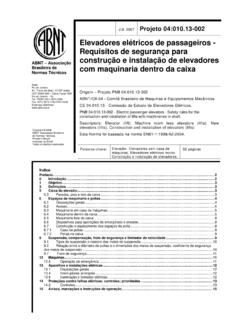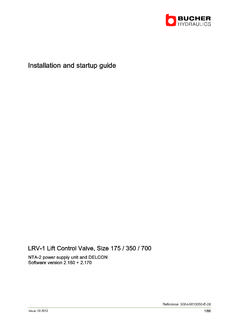Transcription of ELEVATOR IMPACT PROTECTION - Elevator Parts …
1 ELEVATORIMPACTPROTECTIONOleo is a leading expert in energyabsorption technology supplyingsolutions to the ELEVATOR , industrial andrail ELEVATOR buffers are designed to protectpeople and equipment from forces generatedfrom an IMPACT resulting from equipmentfailure or operator error. Oleo has achieved this on most buffer typesusing hydraulic energy absorption systemscombined with a gas return spring to giveunsurpassed energy dissipation and recovery. Oleo has a complete range of ELEVATOR buffersfor every application offering a lighter,stronger, high quality product with minimumlife-cycle costs.
2 Our ELEVATOR buffers are sold worldwideoffering exceptional performance across awide mass and speed range. Oleo buffershave worldwide certification and approvalswhich include , ASME GB7588and buffers are primarily available asstandard designs but we would welcome theopportunity to look at a specific operating principle 3 ELEVATOR safety4 Range overview9 LSB 1010 SEB Series11LB Series12LB High Speed Series13 High Speed Lift Range142 OLEO INTERNATIONAL3 TECHNICALHYDRAULIC OPERATING PRINCIPLEThe illustration shows the robust construction of theOleo ELEVATOR hydraulic buffer unit.
3 On IMPACT theplunger is forced down around the gas rod and throughthe metering tube displacing oil through holes, therebydecelerating the IMPACT mass. Following IMPACT the gashydraulic buffer returns to its full height using a uniquemethod of moving the gas within the buffers performance on IMPACT relies solely on oildisplacement, the gas spring serves only to re-extend the plunger. When the plunger is forced into the cylinder rapidly theoil displaced by the plunger has to pass through themetering holes at very high velocity.
4 This raises thepressure in the oil chamber to a level which optimizes theclosure force of the very useful feature is accomplished by Oleo s innovativemetering designs which progressively alter the flow area asthe unit closes. The actual metering designs are preciselycalculated to provide the best possible Oleo hydraulic unit therefore possesses the uniquefeature that its characteristics change according tooperational needs. The majority of the IMPACT energy isabsorbed within the unit and the already low recoil force isdamped by the reverse flow of oil, leaving very little energyand recoil force to be returned to the impacting TUBEPISTONGAS CHAMBEROIL RESERVOIR4 ELEVATOR SAFETYE levator buffers are safety devices which are required to be mounted at the base of an ELEVATOR shaft.
5 As with any safetydevice, ELEVATOR buffers have to meet with a variety of specifications. One of the most important of these specifications isthe manner in which the buffers must bring an impacting ELEVATOR car to rest. There are different technical specifications forelevator buffers in different regions worldwide however all employ the same basic performance the very early days of elevators, a variety of safety systems have been employed to ensure that the ELEVATOR will notfree fall. The purpose of ELEVATOR buffers is to provide PROTECTION against the malfunction of an ELEVATOR control systemresulting in the ELEVATOR continuing to travel past the lowest stop to the base of the ELEVATOR shaft.
6 The buffers are specifiedin accordance with the operating velocity and mass of the freefall is not a realistic event for an ELEVATOR , the specification and code requirements are based on theassumption of requirement for ELEVATOR buffers fall into two categories depending on the type of buffer. accumulation buffers:These can take the form of simple mechanical springs or polymer buffers which storethe absorbed energy of the IMPACT in the form of strain energy. In some accumulation buffers this stored energy can bedissipated on the return movement of the buffer leading to two separate requirements:a) Buffers with linear and non linear characteristics these can be used if the ELEVATOR does not exceed 197ft/min.
7 B) Buffers with buffered return movement these can be used for elevators that do not exceed 315ft/min. dissipation buffers:These are usually hydraulic buffers which dissipate the energy of the IMPACT in the form ofheat during the travel of the buffer. This type of buffer can be used for all rated speeds, but must be used for speeds of315ft/min or PERFORMANCE CRITERIA ENERGY DISSIPATION BUFFERSP erformance criteria in all specifications is governed by 2 underlying rules which state that the buffer must arrest afreefalling mass travelling at 115% of the rated speed of the ELEVATOR :(i) With an average deceleration not exceeding 1g.
8 (ii) Without exceeding a deceleration of for a time period greater than addition a further, but separate, requirement states that the buffer stroke must be at least as great as free fall distancerequired to reach 115% of the rated ELEVATOR velocity. It is this requirement that dictates the stroke and consequently theinstallation height of ELEVATOR buffers. Due to customer demands, most ELEVATOR buffers do not deviate far from theminimum stroke INTERNATIONAL5 TECHNICALMINIMUM BUFFER STROKES FOR SPECIFIC RATED SPEEDSMINIMUM POSSIBLE STROKE LENGTHS Rated ELEVATOR SpeedType Test Speed 115% of Rated ELEVATOR Speed ft/minft/min 197226 256294 315362 354407 400460 453521
9 500575 620713 701806 799919 10021152 11041270 11991379 12991494 Oleo Buffer TypeMIN StrokeRated BufferMAX BufferReduced StrokeSpeedSpeedElevator Speed(115% of Ratedbefore striking terminalElevator Speed)slowdown device(ASME )inft/minft/minft/min LSB SEB LB SEB SEB LB LB SEB LB LB LB LB LB LB HSL LB LB HSL HSL HSL HSL design engineer must consider the stroke requirements in the overall height of the buffer.
10 If telescopic solutions arenot to be used then the overall height must be at least double the minimum stroke with a further height requirement torestrict lateral movement when the buffer is fully extended. Lateral movement should be restricted to + in per ft of stroke from the TERMINAL SPEED LIMITING DEVICEThe function of an emergency terminal speed limiting device is to automatically reduce the speed of a car or counterweight byremoving power from the driving machine. The device effectively slows the car or counterweight to the rated speed of thebuffer before IMPACT .




